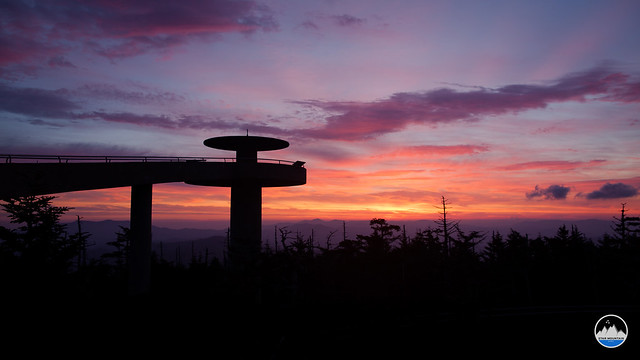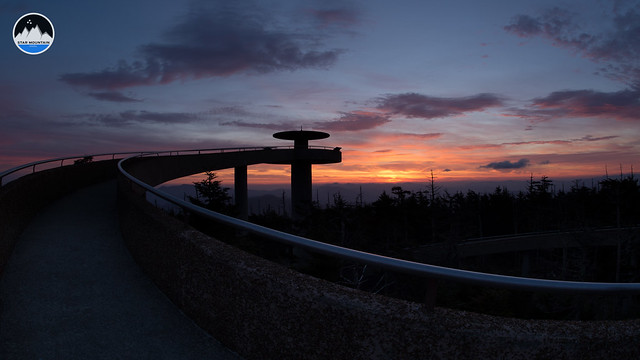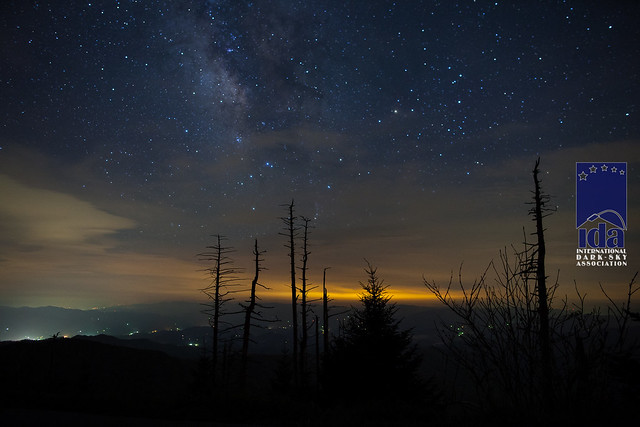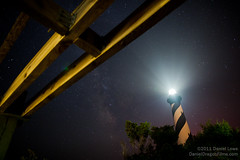
Milky Way photos, an Amazing Sunrise, and a Bear
A Night on top at Clingmans Dome, GSMNP
May, 2013 written by Daniel Lowe
A Night on top at Clingmans Dome, GSMNP
Since moving to the western region of North Carolina, I've been scouting for amazing places to take photos. Especially amazing night photos in areas with little light pollution, where it's possible to capture "the Milky Way" the Magellanic clouds of our Milky Way galaxy.
Lately I've been looking at sites along the Appalachian Trail, which includes tall peaks along the border of North Carolina and Tennessee. The highest point along the Appalachian Trail is a mountaintop called Clingmans Dome. It has a reputation for amazing views; and it did not disappoint. Clingmans Dome is a part of the Great Smoky Mountains National Park.
View Larger Map
Smoky Mountain Spaceport
For several years, I've been taking photos of the night sky and the Milky Way galactic core.
The challenge in photographing the night sky is often finding the proper subject for framing and composition to create a memorable, interesting image.
That was not an issue at Clingmans Dome: the observation tower has a lovely curved line and circular form, it's high in the air; perfect for composition with sky images. I was very pleased with the focus and tower detail in the following image, titled "Smoky Mountain Spaceport". This photo was taken with a Canon 5DmkII and Samyang 24mm f/1.4 lens, set to 25s, ISO 1600, f/4.

A Most Memorable Sunrise
As an outdoor photographer with a few years of experience, I have seen a fair share of amazing sunrises and sunsets.
Even by elevated standards, this was an extraordinary sunrise. I was fortunate to be able to capture it with not one, but two cameras.
Here's the first photo, showing an extraordinary yellow and orange color in the sky, at "nautical dawn" just before sunrise.

Light Painting with Green Laser & Red Headlamp
In the last few years, I've seen some amazing work with light painting
including photos using colored LEDs, headlamps, and laser pointers.
Recently, a friend loaned me a green-colored laser light pointer; I wanted to try using this in some of my images. When I arrived at the top of Clingmans Dome, the Milky Way was not yet visible.
I set up a time-lapse sequence, then climbed to the top of the observation deck so I could be included with the green laser pointer and red LED headlamp in the following photo, titled "Laserbeam / Signaltower"

My footing was not ideal, and I found it difficult to hold still for the full 25 second exposure.

Loss of Focus?
Recently, I acquired a used Nikkor 16mm f/2.8 prime lens from a seller on eBay.
This lens has a rear bayonet filter, and my particular lens had only the 'A2' rear filter included.
After some research, I discovered that the A2 designation means this filter is an Neutral Density (ND) 0.4 filter to reduce exposure. Since I knew I wanted to take photos of the stars, I removed this filter. At the time, I was not aware of it, but that means that I lost the ability to focus with this lens to infinity.
Long story short: All of the night photos with my Nikon D600 camera were out of focus. I've ordered a clear replacement rear filter for the Nikkor 16mm lens.. Not really a big deal, but it's annoying to lose some cool wide-angle Milky Way photos!
While I was taking photos of the dawn, about 20 minutes before the actual sunrise, a couple came up to view the sunrise. They had European accents; I have no idea what country they may have been from. When I took a photo of the sunrise on Mt. Mitchell, I met a similar couple from Switzerland.
When I closed the aperture on the 16mm Nikkor lens to f/8, I began to gain better focal depth. I was able to compose the following photo using the railing as a leading line.

Encounter with Bear
After taking the sunrise photos and meeting the couple from overseas, I packed up my gear and headed down the trail.
I could see them walking down the paved path about 50 meters in front of me. I was in a great mood, but very tired.
And then, suddenly, I realized I had walked to within 8 meters of a medium sized, American Black bear.
I stopped in my tracks. I looked straight at him, and the bear looked back at me for a moment. (pro tip: don't do this; Here's an article on how to survive encounters with wild animals on Fast Co. Create.) The bear was eating something, munching on some kind of leafy green plant.
 My thoughts went to the small amount of food (some leftover nachos) that I was carrying; I knew the bear could smell this.
I backed up on the trail, slowly, putting some distance between us and breaking our line of sight.
I called out, "hey, bear!" which I had seen hikers do, in a National Geographic special on the Appalachian Trail.
My thoughts went to the small amount of food (some leftover nachos) that I was carrying; I knew the bear could smell this.
I backed up on the trail, slowly, putting some distance between us and breaking our line of sight.
I called out, "hey, bear!" which I had seen hikers do, in a National Geographic special on the Appalachian Trail.
I thought about taking out the 300mm lens and taking a photo of the bear..but this was my first bear encounter, and staying alive seemed to be the highest priority.
Maybe, next time.
(bear photo from Wikipedia Commons)
Slowly, Losing a Natural Dark Night Sky
Although it was possible to photograph the Milky Way from Clingmans Dome, the night sky showed quite a bit of artificial light pollution (mainly from the resort city of Gatlinburg, TN to the west).
It was difficult to see the Milky Way galaxy with the naked eye at this location.
If communities continue to light their homes and businesses in the traditional manner, we may lose all connection to the dark, natural night sky.
For more information on what you can do to help, visit the Frequently Asked Questions about Light Pollution on the website of the International Dark Sky Association.

 Night Motion Timelapse: Outer Banks
Night Motion Timelapse: Outer BanksThe Outer Banks has very dark skies with little light pollution. I went to Salvo, N.C. under the new moon in April and.. (see more)
Copyright 2011-2014 by Daniel Lowe